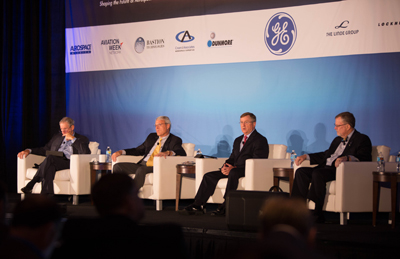Diagnosing the High Costs of Rockets, Satellites and Airplanes Written 28 July 2015
Panelists: Moderator Michael D. Griffin, Schafer Corp.; Frank Culbertson, Orbital ATK; Mike Hawes, Lockheed Martin Corp.; Lee Monson, retired from Boeing Co.
by Ben Iannotta, Editor-in-Chief, Aerospace America

Why are government satellites, rockets and aircraft so darn expensive? The answer can be boiled down to a single word: Fear — fear of test failures; fear of bid protests; fear of losing political support.
That was the dominant message from “Cost and Affordability of Future Systems,” a 2015 AIAA Propulsion and Energy Forum panel.
“The paranoia of making a mistake and losing your job drives people to overdo things,” said former space station astronaut Frank Culbertson, now president of Orbital ATK’s Space Systems Group.
When it comes to rocketry, “we’ll be more successful in operations if we do have a few [test] failures sometimes,” he said. Even when there is a flight failure that destroys cargo or lives, “you’re going to be stronger the next time around, just as we were in the shuttle program, just as we are in Antares, just as SpaceX is doing right now,” Culbertson said, referring to the explosion of an Antares rocket in 2014 and the June disintegration of a SpaceX Falcon 9 rocket on its way to orbit.
To illustrate how excessive caution drives up costs, Culbertson told a story about attempting to test a new solid rocket motor.
“It took us 30 days to get clearance from the customer to actually do that test, when if we had just done the test and it failed, we could have had it going again in two weeks,” he said.
Fear also affects costs in subtler ways. Government contracting officers live in fear of successful bid protests, so they “lay out a paper trail of fairness and transparency,” said former NASA Administrator Michael D. Griffin, now chairman and CEO of Schafer Corp. “It’s nice that America chooses to be fair, but it’s extremely expensive to do so.”
That’s not a problem in the commercial world. “Procurement decisions are made for individual items based on what will yield the most value, or the perceptions of the value, in the end product,” Griffin said.
Griffin asked panelist Lee Monson, a retired Boeing Co. executive who once sold airliners in the Middle East, whether airlines have any desire to own the aircraft technologies they rely on. Monson said airlines care about the configuration of seats and also about the “long-term maintainability” of their planes, but they don’t want responsibility for the design and technology.
“Because of the regulatory forces that get imposed upon them, they would just as soon that that stay with the manufacturer,” Monson said.
In the government, fear of losing political support for large undertakings has historically led managers to distribute work across as many U.S. states as possible. The issue persists in such areas as missile defense and large Air Force programs, Griffin said.
Mike Hawes, vice president and Orion program manager with Space Systems at Lockheed Martin Corp., said the political motivations for distributing work are sometimes overstated.
“There are a lot states that I buy stuff from that I don’t have a political reason to go buy from that state. So, I rankle at that a little bit,” he said, meaning the notion “that it’s all politically driven.”
In one sense, fear is not necessarily a bad thing. In the commercial world, noted Griffin, market forces are intense. “Almost everyone in the company is co-aligned in their motivations. Executive bonuses, executive salaries, even continued employment is contingent on doing things in a very balanced way,” he said.
In government procurement, “we need something to substitute for market forces,” Griffin said.
